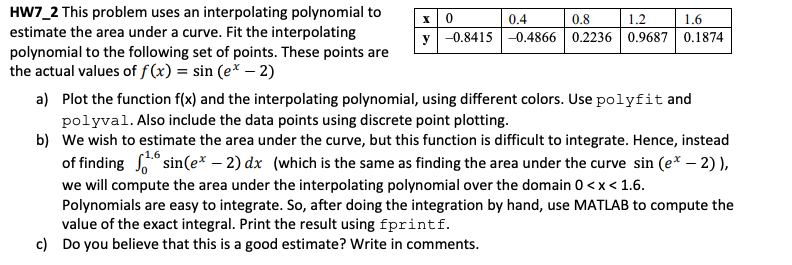HW7_2 This problem uses an interpolating polynomial to estimate the area under a curve. Fit the interpolating polynomial to the following set of points. These points are the actual values of f(x) = sin (e* – 2) 0.4 0.8 1.2 1.6 y -0.8415 -0.4866 0.2236 0.9687 0.1874 a) Plot the function f(x) and the interpolating polynomial, using different colors. Use polyfit and polyval. Also include the data points using discrete point plotting. b) We wish to estimate the area under the curve, but this function is difficult to integrate. Hence, instead (1.6 in(
HW7_2 This problem uses an interpolating polynomial to estimate the area under a curve. Fit the interpolating polynomial to the following set of points. These points are the actual values of f(x) = sin (e* – 2) 0.4 0.8 1.2 1.6 y -0.8415 -0.4866 0.2236 0.9687 0.1874 a) Plot the function f(x) and the interpolating polynomial, using different colors. Use polyfit and polyval. Also include the data points using discrete point plotting. b) We wish to estimate the area under the curve, but this function is difficult to integrate. Hence, instead (1.6 in(
Computer Networking: A Top-Down Approach (7th Edition)
7th Edition
ISBN:9780133594140
Author:James Kurose, Keith Ross
Publisher:James Kurose, Keith Ross
Chapter1: Computer Networks And The Internet
Section: Chapter Questions
Problem R1RQ: What is the difference between a host and an end system? List several different types of end...
Related questions
Question

Transcribed Image Text:HW7_2 This problem uses an interpolating polynomial to
estimate the area under a curve. Fit the interpolating
polynomial to the following set of points. These points are
the actual values of f(x) = sin (e* – 2)
0.4
0.8
1.2
1.6
y -0.8415 |-0.4866 0.2236 0.9687 0.1874
a) Plot the function f(x) and the interpolating polynomial, using different colors. Use polyfit and
polyval. Also include the data points using discrete point plotting.
b) We wish to estimate the area under the curve, but this function is difficult to integrate. Hence, instead
1.6
of finding ° sin(e* – 2) dx (which is the same as finding the area under the curve sin (e* – 2) ),
we will compute the area under the interpolating polynomial over the domain 0 <x< 1.6.
Polynomials are easy to integrate. So, after doing the integration by hand, use MATLAB to compute the
value of the exact integral. Print the result using fprintf.
c) Do you believe that this is a good estimate? Write in comments.
Expert Solution
This question has been solved!
Explore an expertly crafted, step-by-step solution for a thorough understanding of key concepts.
This is a popular solution!
Trending now
This is a popular solution!
Step by step
Solved in 4 steps with 2 images

Recommended textbooks for you

Computer Networking: A Top-Down Approach (7th Edi…
Computer Engineering
ISBN:
9780133594140
Author:
James Kurose, Keith Ross
Publisher:
PEARSON

Computer Organization and Design MIPS Edition, Fi…
Computer Engineering
ISBN:
9780124077263
Author:
David A. Patterson, John L. Hennessy
Publisher:
Elsevier Science

Network+ Guide to Networks (MindTap Course List)
Computer Engineering
ISBN:
9781337569330
Author:
Jill West, Tamara Dean, Jean Andrews
Publisher:
Cengage Learning

Computer Networking: A Top-Down Approach (7th Edi…
Computer Engineering
ISBN:
9780133594140
Author:
James Kurose, Keith Ross
Publisher:
PEARSON

Computer Organization and Design MIPS Edition, Fi…
Computer Engineering
ISBN:
9780124077263
Author:
David A. Patterson, John L. Hennessy
Publisher:
Elsevier Science

Network+ Guide to Networks (MindTap Course List)
Computer Engineering
ISBN:
9781337569330
Author:
Jill West, Tamara Dean, Jean Andrews
Publisher:
Cengage Learning

Concepts of Database Management
Computer Engineering
ISBN:
9781337093422
Author:
Joy L. Starks, Philip J. Pratt, Mary Z. Last
Publisher:
Cengage Learning

Prelude to Programming
Computer Engineering
ISBN:
9780133750423
Author:
VENIT, Stewart
Publisher:
Pearson Education

Sc Business Data Communications and Networking, T…
Computer Engineering
ISBN:
9781119368830
Author:
FITZGERALD
Publisher:
WILEY